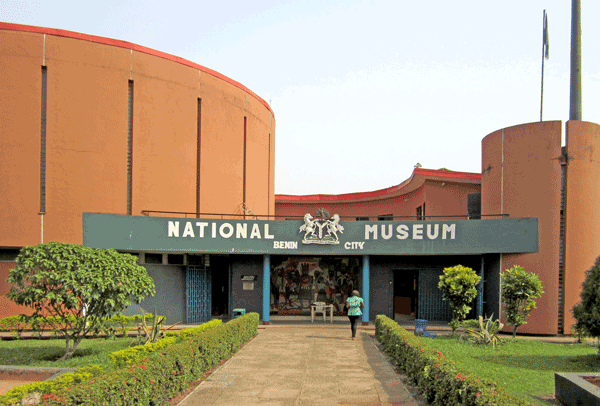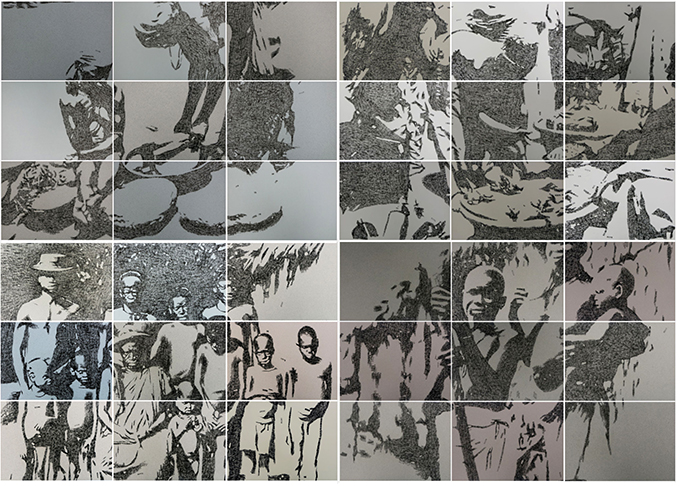
On 21 September 2019, the [Re:]Entanglements: Contemporary Art & Colonial Archives exhibition opened at the National Museum, Lagos. The opening event was attended by an estimated 300 people, including many from Nigeria’s vibrant arts scene. Following on from our successful exhibition in Benin City, this collaboration between the [Re:]Entanglements project, the National Museum, and the Lagos-based artist Kelani Abass continues our exploration of artistic engagements with the archival traces of Northcote Thomas’s anthropological surveys.
![Scenes from opening of [Re:]Entanglements exhibition, National Museum, Lagos](https://re-entanglements.net/wp-content/uploads/2019/10/National_Museum_Lagos_exhibition_opening_re-entanglements.net_.jpg)
Unlike the Benin exhibition, this initiative focused specifically on the photograph albums from Thomas’s three Nigerian surveys, which we have discovered in the National Museum library and archive collections. Indeed, these albums, dating from 1909 to 1913, appear to be the only substantial archival traces of Thomas’s anthropological surveys to have survived in Nigeria. The initiative is also different insofar as it features the work of a single artist rather than a collective.
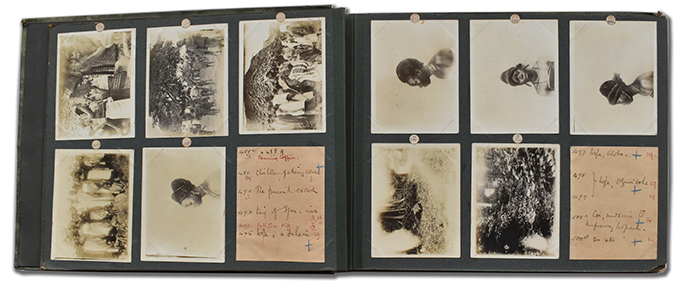
Over the course of a year, Kelani Abass has produced two series of works for the exhibition under the common title of Colonial Indexicality. These both employ techniques developed in earlier works by Abass, including his Calendar and Stamping History series, first exhibited at exhibitions at the Centre for Contemporary Art, Lagos in 2013 and 2016 respectively. In both of these series, Abass explored a more personal history through sifting through the archives of his parents’ printing business in Abeokuta, incorporating both the technologies of hand-operated letter-press printing and the accumulated materials – photographs, leaflets, design motifs – deposited at the press by customers. The Colonial Indexicality series produced for the [Re:]Entanglements exhibition connects this family history with a broader cultural history as refracted through Northcote Thomas’s colonial anthropological lens.
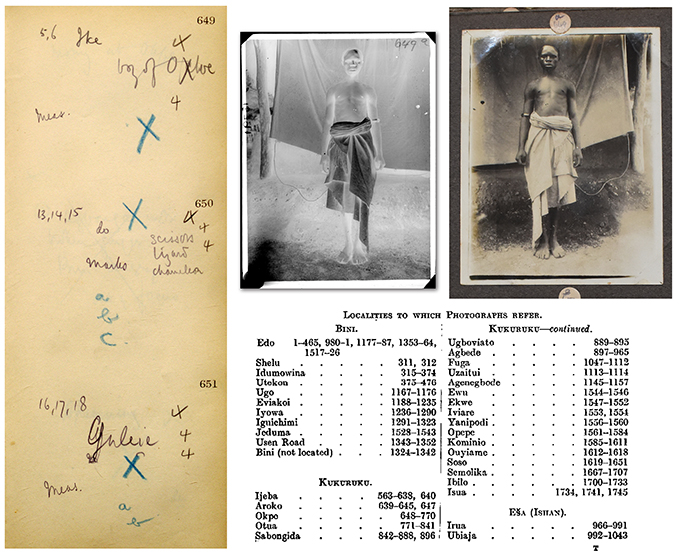
The pervasiveness of numbering systems and indexes are, of course, characteristics of all archives, and the archives of Thomas’s anthropological tours are no exception. Thomas numbered each of his photographic negatives, for example, and he made notes about each negative in a series of pre-numbered photographic register books. Most literally, the negative number acts as an index in relation to corresponding prints, but also indexes other information, for instance, the identity of the person photographed, where the photograph was taken, and places the particular photograph in relation to a sequence. We know, for example, that Thomas’s negative number 649 is of a boy named Ike, and is one of a series of 122 photographs that Thomas made in Okpe in present-day Edo North in 1909. There is a further note in the corresponding photographic register – ‘meas.’ – short-hand for ‘measurement’, recording that Thomas also recorded Ike’s anthropometric measurements, indexing how this young man entered other forms of colonial scientific calculation.
It is no surprise, then, that the theme of numbers and numbering emerges prominently in Abass’s artistic responses to the albums in the National Museum. Indeed, each work in the Colonial Indexicality series bears a simple number as its title – the number of the particular photograph the work itself indexes.
![[Re:]Entanglements exhibition view, National Museum, Lagos](https://re-entanglements.net/wp-content/uploads/2019/10/National_Museum_Lagos_exhibition_view_re-entanglements.net_.jpg)
The principle of indexicality is also evident in the very grammar of the exhibition. In the first room of the exhibition, we brought three elements into relation: examples of the original photograph albums from Thomas’s 1909-10 Edo tour; enlarged digital prints of a selection of pages from these albums; and a series of 12 mixed media paintings by Abass that respond to the particular qualities of these albums.
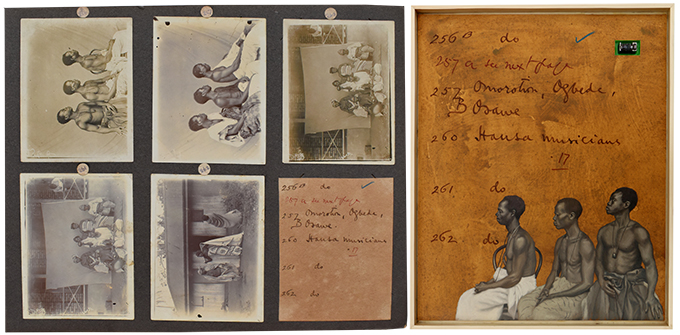
The pages of the Edo albums are arranged in a uniform manner, with five photographs in a grid with a paper index panel cut to the same size as the prints and pasted in the grid. For each of the 55×68 cm paintings, created in acrylic and oil on canvas, mounted onto board, Abass reproduces these index panels as his backgrounds. He captures the ‘texture’ of the yellowed parchment-like paper panels, complete with Thomas’s handwriting and various other ticks, annotations and crossings-out that have been added in different coloured inks. He then selects one of the photographs from the same album page, which he paints in tones which evoke the photographic originals. The number of the photograph is used as a title for the work, which is also inset into the painting either using letterpress types or components of a numbering machine.

In the second room of the exhibition, the juxtaposition of original archives, digital prints and Abass’s contemporary artworks continues. Additional themes of disintegration and dissolution are invoked here, pointing to the fragility of the archive and the impermanence of memory. In one 105×127 cm digital print of an album page from Thomas’s 1912-13 tour of Igbo-speaking peoples, for example, the faces in Thomas’s physical type photographs have faded to little more than ghostly impressions. Indeed, one objective of the exhibition was to draw attention to the urgent need for better storage and conservation of the National Museum’s important archival collections.
![[Re:]Entanglements exhibition view, National Museum, Lagos](https://re-entanglements.net/wp-content/uploads/2019/10/National_Museum_Lagos_exhibition_view_2_re-entanglements.net_.jpg)
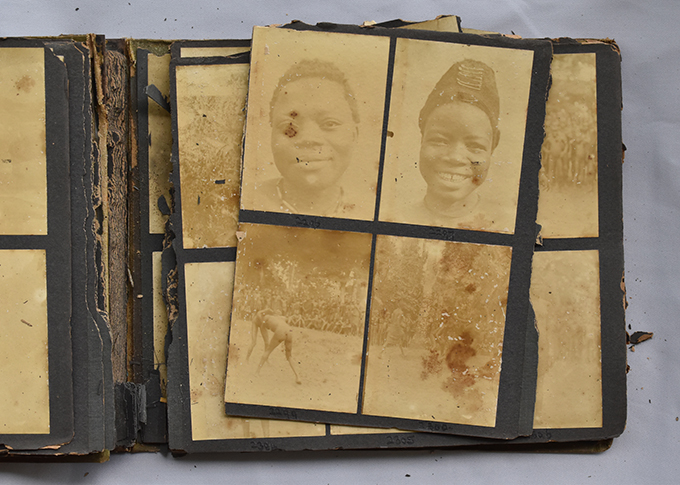
Abass refers to the second series of works in Colonial Indexicality as a continuation of a ‘performative oeuvre’ that ‘calls attention to the interplay of manual and mechanical processes involved in the production of printed works, photographs and drawings’. This work comprises of five interlinked 126×90 cm ‘drawings’ of Northcote Thomas photographs, which have been laboriously made using a hand numbering machine.

The use of the numbering machine as a medium again relates to Abass’s family history and childhood memories. After a day at school, Abass and his siblings would help out in their parents’ print shop, using these automatic numberers to stamp sequences of numbers in newly printed invoice books and other stationery. In relation to the [Re:]Entanglements project, Abass was struck by the sequential printed numbers evident in the stationery used by Northcote Thomas. Indeed, to create these ‘stamping history’ drawings he used stamping machines with a similar font style to the numbers used in Thomas’s photographic registers.
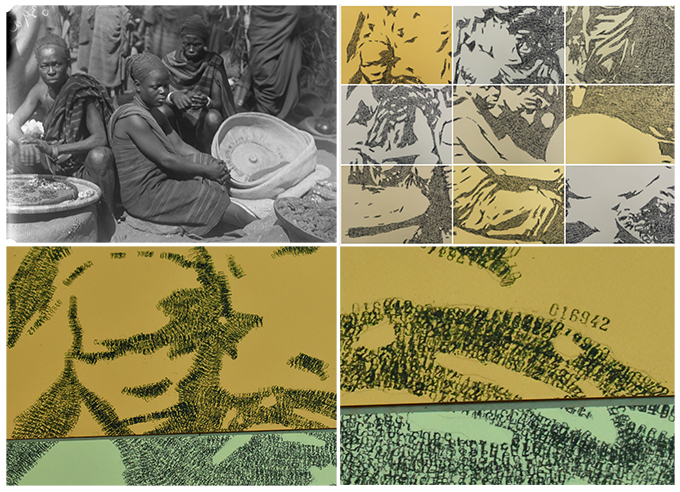
The numbers that Abass stamps in these works are not arbitrary either. They index both the specific photographs from the Thomas archives that Abass reproduces, but also act as a form of accountancy, allowing Abass to quantify his artistic labour and reflecting the labour entailed in producing the anthropological archive in the first place. Thus, Abass’s first impression in this work was the number 1155, corresponding with Thomas’s negative number 1155. After each impression, the number on the stamping machine increases by a digit to 1156, then 1157 and so on. At the end of the process of creating these five works, the final number stamped was 85,867. Thus Abass is able to quantify the work as representing 84,710 acts of stamping – this Abass conceptualises as a process of ‘stamping history’, and of ‘making or marking time’.
The grid-like layout of these five ‘drawings’ echoes the layout of the photographs in Thomas’s albums, but also speaks to the fragmentary nature of the archive – an assemblage of parts that must be assembled together in order to make sense. The actual archive is rarely so complete, and the bigger picture is often based on as much conjecture as it is evidence.
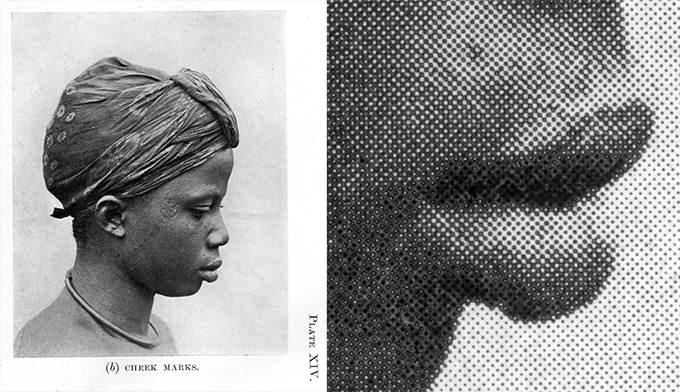
It is, of course, only when one stands back from Abass’s large-scale stamped drawings that the picture, quoted from Thomas’s archive, becomes clear. Up close, one sees a mess of over-lapping stamped numbers. Seen from a distance, however, the individual numbers from which the pictures are made disappear and the eye perceives the pattern. It is the same principle as halftone printing – the technique used to print Thomas’s photographic plates in his published reports (a set of which also resides in the National Museum library). Indeed, the same principle applies to Thomas’s original photographic negatives and our digital scans of them today, in which the coating of granular light-sensitive crystals is translated, imperfectly, into pixels. Switching to a metaphorical register, Abass’s work reminds us that what we perceive in the colonial archive depends on where we stand, as well as how close we look.
[Re:]Entanglements: Contemporary Art & Colonial Archives is open at the National Museum, Lagos until 27 October 2019. Do go along if you can and let us know what you think!
Kelani Abass [Re:]Entanglements exhibition
![Kelani Abass [Re:]Entanglements Contemporary Art & Colonial Archives Exhibition, National Museum Lagos](https://re-entanglements.net/wp-content/uploads/2019/08/Kelani_Abass_exhibition_National_Museum_Lagos_re-entanglements.net_.jpg)
We are delighted to announce the next [Re:]Entanglements project exhibition, which will be taking place at the National Museum, Lagos, between 21 September and 27 October 2019.
The exhibition is the outcome of a collaboration between the [Re:]Entanglements project, the Lagos-based artist Kelani Abass, and the National Museum, Lagos. The exhibition features a series of new contemporary artworks by Kelani Abass, which respond to archival holdings in the National Museum of Northcote Thomas photograph albums. This will be the first exhibition at the National Museum that focuses on the Museum’s archival collections, and that brings together contemporary art and colonial archives.
The photograph albums were originally deposited at the Colonial Secretariat in Lagos at the time of Northcote Thomas’s anthropological surveys. They are the only substantial part of the Thomas collections that remains in Nigeria. At the beginning of the [Re:]Entanglements project, we believed these to be duplicates of photograph albums that are held in the UK’s National Archives (originally kept in the Colonial Office Library in London) and at the University of Cambridge Museum of Archaeology and Anthropology. When we tracked the albums down, however, we discovered that the albums from Thomas’s 1909-10 tour in Edo-speaking areas of Nigeria were actually very different from the albums in the UK, not least in the layout of the photographs on the pages and inclusion of additional descriptions on each page.

The exhibition will include displays of the original albums, and juxtaposes Kelani Abass’s new works, produced on various media, with large scale digital prints of pages from the albums. Abass has created two series of works for the exhibition under the title Colonial Indexicality. First, is a series of 12 works produced using acrylic, oil on canvas and letterpress type, which explores the archival textures of the albums from Thomas’s Edo tour. The paintings reproduce the yellowed paper panels on the album pages, including texts in various coloured inks and pencils, some in Thomas’s own hand. On each canvas Abass has painted one of the photographs from the corresponding album page, capturing the aging of the photographic images in the subtle tones of his paint. Inset in each panel, letterpress type blocks with the corresponding number of the photographic image is set.
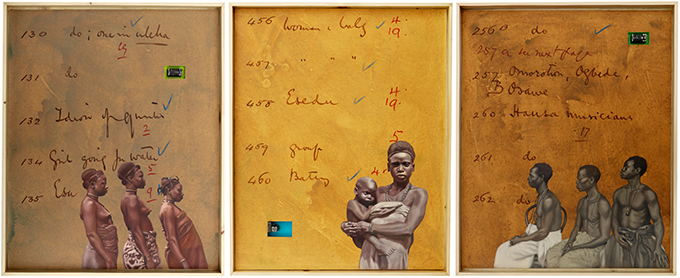
A second series of works forms a large-scale intersecting collage reproducing five of Thomas’s photographs. Remarkably, these are ‘painted’ using a hand automatic number stamping machine. Like dots in halftone photographic printing, from a distance the photographic image can be seen, but as one approaches, the integrity of the image breaks down to its component ‘dots’, which in this case are each unique numbers. This speaks powerfully to seemingly obsessive use of numbers used by Thomas to index not only the photographs he made during his anthropological surveys, but also his sound recordings, artefact collections, botanical specimens and indeed every page of fieldnotes. This gives rise to the title of Abass’s work for the project, Colonial Indexicality.

The ‘dissolution’ of the photographic archive so powerfully evoked in Abass’s works, is reflected too in the large scale digital prints of Thomas’s original albums. As such the exhibition is also a reflection on the precarious state of the archive itself – especially in West African institutions. The condition of the albums is extremely poor as a result of the environmental conditions in which they have been stored and pest damage. They, along with many other collections in West African museums and archives, are in urgent need of conservation care if they are to survive. This can be seen, for example, in the way in which the photographs in some of the albums have faded – in some cases, they have become almost invisible. As well as drawing attention to the precarity of the archive, this speaks eloquently to fading of memory – something that we have been very aware of during fieldwork in Nigeria and Sierra Leone.
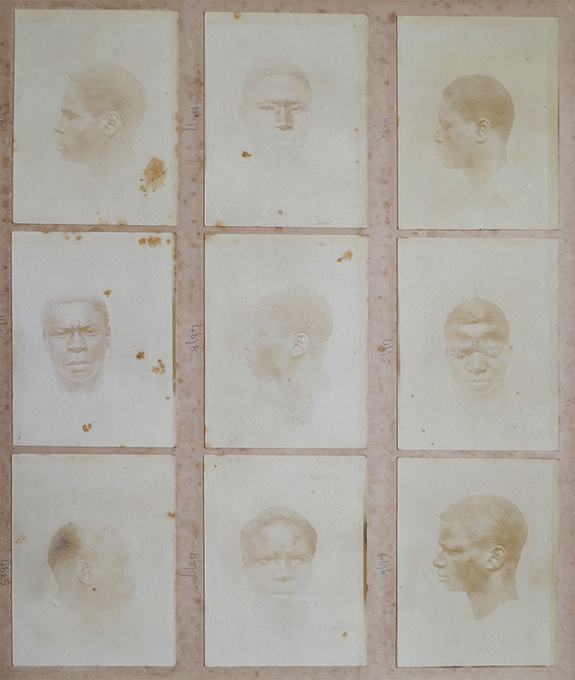
It has been especially rewarding working with Abass on this collaboration, since the themes of the [Re:]Entanglements project link closely with themes that he has been exploring in other work over a number of years (see, for instance, this interview with Kelani Abass). We were introduced to the work Abass produced for his solo exhibitions If I Could Save Time and Àsìkò: Evoking Personal Narratives and Collective History at the Centre for Contemporary Art (CCA), Lagos, and we are especially grateful to Iheanyi Onwuegbucha, curator at CCA, for working with us on the curation of the exhibition at the National Museum. We are also very grateful to Mrs Omotayo Adeboye, Curator of the National Museum, and Mr Taye Pedro, Librarian and Archivist at the National Museum, for providing access to the collections and hosting the exhibition. Without their support the exhibition would not be possible.
[Re:]Entanglements: Contemporary Art & Colonial Archives is on at the National Museum, Onikan, Lagos between 21 September and 27 October 2019. See our next blog about the exhibition, including video documentation of its installation and opening event.
Panoramic photography and photographic excess

Northcote Thomas used a number of different cameras during his four anthropological surveys in West Africa between 1909 and 1915. During his first tour, in Edo-speaking areas of Nigeria, his equipment list included a Hunter & Sands Tropical camera and a Goerz camera. On his three subsequent tours, in Igbo-speaking areas of Nigeria and in Sierra Leone, however, his photographic kit included three cameras: an Adams Videx camera, a Stereoscopic camera, and a Kodak Panoram camera. The majority of Thomas’s photographs were taken on quarter plate glass negatives on the Videx, but it is clear that Thomas experimented with both stereoscopic photography, also using quarter plates, and panoramic shots using the Kodak Panoram, which used 105 format roll film.
Through the [Re:]Entanglements project, we have been systematically digitising all of N. W. Thomas’s photographic negatives and prints with our partners at the Royal Anthropological Institute and University of Cambridge Museum of Archaeology & Anthropology. Until recently, we believed that only Thomas’s quarter plate glass negatives and corresponding prints had survived. However, we were excited to discover quite a number of his panoramic prints in the collections in the Museum of Archaeology & Anthropology. On a recent research visit to the National Museum in Lagos, Nigeria, we were also delighted to find a number of these panoramic prints mounted in one of the photograph albums produced during Thomas’s surveys.

The Kodak No.1 Panoram camera, which Thomas used, was manufactured between 1900 and 1926. The camera had a swinging lens, which took 3.5 x 12 inch exposures across a 112 degree arc on 105 film stock. An advertisement of the time asserts that ‘The pictures taken by these instruments have a breadth and beauty not attainable with the ordinary camera. The wide scope of view makes the Panoram excellent for taking landscapes, as it can cover a wide area without the distortion incident to the use of wide angle lenses’. There is an excellent article on the Kodak No.1 Panoram at Mike Eckman Dot Com.
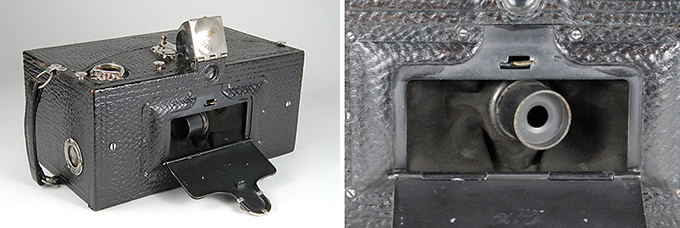
The more we explore Northcote Thomas’s fieldwork photography, the more we learn how innovative he was for the time. For example, during his 1910-11 tour in what was then Awka District, he experimented with using two cameras simultaneously to photograph a scene from different angles. This technique would, of course, become an important technique in cinematography. (The earliest known example of a two-camera set up in cinema was the 1911 Russian film Defence of Sevastopol.) In the example here, we can see that Thomas and his assistants simultaneously photographed what is described as the Ogugu ceremony at Agulu, south of Awka, using both the Adams Videx and Kodak Panoram cameras.
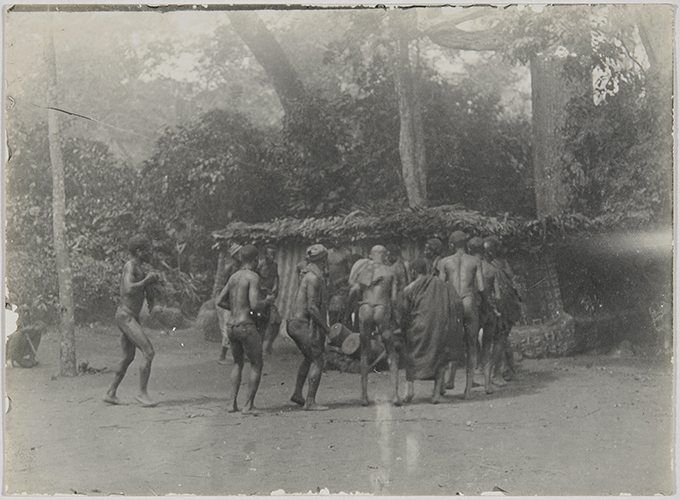
In the resultant sequences of photographs there is a further intrigue, which speaks of the ‘excess’ of the photographic image, and particularly the peripheral presences that creep into the frame without the photographer’s awareness. Of over 7,000 photographs in the archive, there are perhaps only three or four that intentionally show something of the process of Thomas’s anthropological survey work. It is only through this photographic excess that we catch glimpses of the endeavor.
To date, then, the only photographs we have seen in which we glimpse Northcote Thomas behind the camera are the reverse shots of the Ogugu ceremony at Agulu taken by one of his assistants on the Kodak Panoram. In the background of the panoramic shot we see Thomas stood behind the tripod mopping his brow together with three of his assistants and items of his kit strewn around. A rare insight into the anthropologist-photographer at work.


